Calibrated
Results
Brightness and Contrast Ratio
For those that need accurate colors, you really need hardware color calibration. Here, we report scores for the same areas as we did on the previous page, only this time we gather the results after we calibrate the display with Monaco Optix XR Pro.
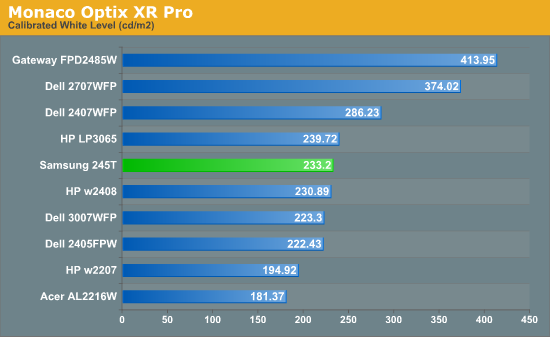
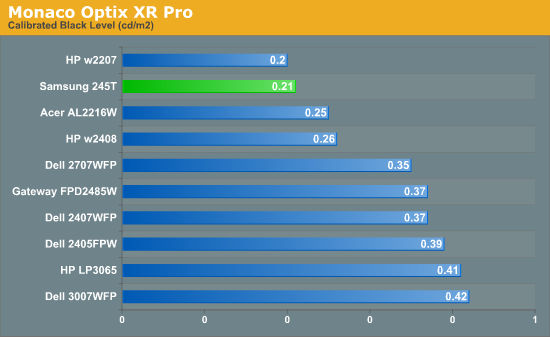
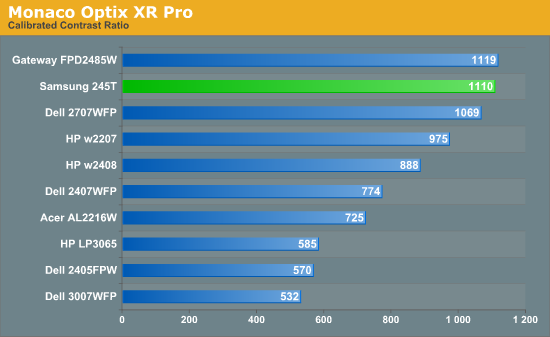
Color Accuracy
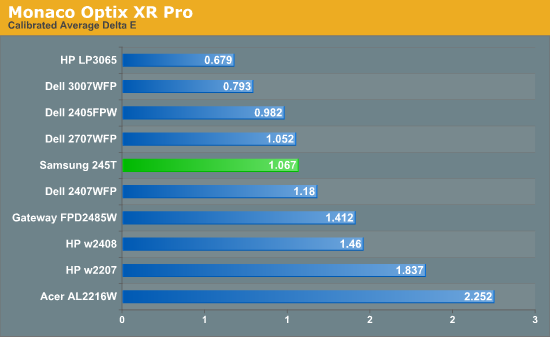
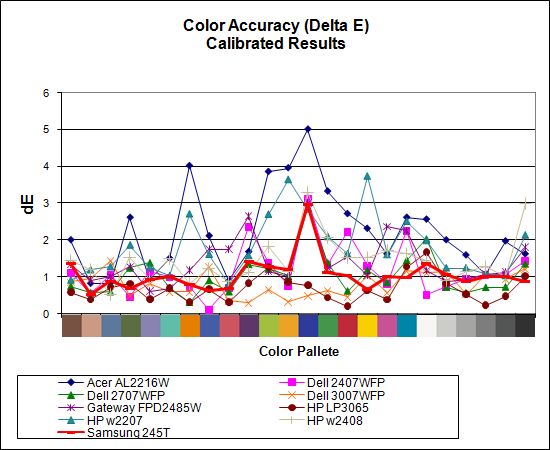
Calibration is usually best at decreased brightness levels, and we found dropping the 245T from its default settings down to 30% brightness (and keeping the default 75% contrast) with RGB settings of 36/50/50 resulted in the best scores. (Note that the red by default seems to be brighter than necessary.) We test indoors with a moderate amount of lighting, and adjust the displays according to directions. The Samsung 245T ends up ranking as one of the best LCDs we've tested, post-calibration, with a score of 1.07. Nearly all of the scores are close to 1.0, and only one color as a Delta E above 2.0.
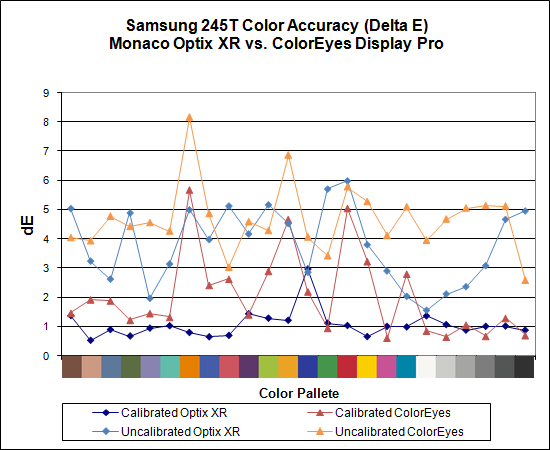
We also tested with ColorEyes Display Pro to see if we could achieve better results. So far, we have yet to encounter a desktop LCD that scores better using ColorEyes Display Pro, which is actually surprising to us -- it seems more robust in many areas and generates newer ICCv4 profiles, but the final reported scores continue to be lower on desktop displays.
While we cannot make any sort of guarantee that the color profiles we created are anywhere near representative of all 245T panels, we frequently get requests from readers for these color profiles. If you want truly accurate colors, your best bet is to go out and invest $300 in a colorimeter and software calibration package. If you're still interested in trying out our profiles, however, we are happy to make them available. Again, your mileage may (re: will!) vary.










60 Comments
View All Comments
alainiala - Friday, February 8, 2008 - link
I do A LOT of monitor testing at my work because I'm one of a handful of people responsible for setting our enterprise hardware standards. I try to steer our company away from TN-based panels, but sometimes its unavoidable (all but one 22" panel that I'm aware of are TN). I find S-PVA to be acceptable, but the true beauties are the S-IPS monitors. NEC makes some of the best S-IPS monitors around, but they are very pricey. My favorite monitors is undoubtably the NEC 2490WUXi, but you have to be prepared to sell an organ to get one. Not worth it for the average user, but anybody with color-critical apps should take a long hard look at it. I do wish more manufacturers would stick with S-PVA and S-IPS... But alas, the pricepoints demand we all get stuck with TN garbage.Pjotr - Friday, February 8, 2008 - link
TVA -> PVAJarredWalton - Friday, February 8, 2008 - link
Fixed, thanks - after writing an article for so many hours, some things start to blur past your eyes. :)uethello - Thursday, February 7, 2008 - link
The panel being listed as TN is ominous to me. I've been studying monitors hard for about a month (since I found out how much of my money Uncle Sam is giving me). Seems like some manufacturers build monitors with both types of panels. Going for the "Hope" buy, I guess. The person who hears about someone getting a good panel and buying in the hopes of not getting a TN.JarredWalton - Friday, February 8, 2008 - link
I talked to my contact at Samsung and got this response on the panel:"As to your question, the 245T does have an S-PVA panel, which is a far superior technology than TN, not that I need to tell you that. The 245BW uses a TN panel. The proper authorities have been notified and they’re working on fixing [the PDF] immediately. I appreciate you letting me know."
So no worries - the 245T is an S-PVA panel as reported and as the images show.
Dainas - Thursday, February 7, 2008 - link
...all manufacturers are seemingly phasing out all mva/pva panels below $650, replacing them with TN at the same pricepoint and no one cares. It surprises me that the reviewers despite not being a big fan of $500+ TN panels, have not noted this plain as day trend.JarredWalton - Thursday, February 7, 2008 - link
Ummm... did you read my HP w2408 review? I pretty much slammed on that trend and said that IMO the TN panels still suck by comparison. I also praised this LCD for not being a TN panel. How is that "not noting the trend"?Dainas - Thursday, February 7, 2008 - link
ok, you noted that much :P Except for what amount to closeout deals, we are starved for choice compaired to 6 months ago. Its not just a matter of waiting for things to get back up to swing after the chinese new year. Besides the expensive stalwarts such as this and the dells line, TN is just eating up everything else was :(I would expect nothing short of a full blown rant about this, hehe.
strikeback03 - Friday, February 8, 2008 - link
Aside from closeout deals and Black Friday specials and the like, have there ever been 24" LCDs that didn't use TN panels available "cheaply"? Seems that when the 24" LCDs were initially all good panels and all expensive, then as more came out the prices dropped some, then someone started making 24" TN panels and those monitors formed a whole separate price bracket.JarredWalton - Friday, February 8, 2008 - link
I believe there are some S-PVA 24" panels for around $400-$450. Are they good LCDs, or are they the reject S-PVA panels that couldn't be put in $600 LCDs? I don't know - I'd like to get one to test, but unfortunately the budget LCD companies aren't interested in sending us review samples. Anecdotally, I've heard that while they are usually better than TN panels, they've got other issues - firmware, low build quality, etc.